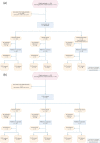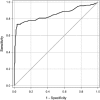Non-invasive assessment of peripheral arterial disease: Automated ankle brachial index measurement and pulse volume analysis compared to duplex scan
- PMID: 27493755
- PMCID: PMC4959301
- DOI: 10.1177/2050312116659088
Non-invasive assessment of peripheral arterial disease: Automated ankle brachial index measurement and pulse volume analysis compared to duplex scan
Abstract
Objectives: This cross-sectional study aimed to individually and cumulatively compare sensitivity and specificity of the (1) ankle brachial index and (2) pulse volume waveform analysis recorded by the same automated device, with the presence or absence of peripheral arterial disease being verified by ultrasound duplex scan.
Methods: Patients (n=205) referred for lower limb arterial assessment underwent ankle brachial index measurement and pulse volume waveform recording using volume plethysmography, followed by ultrasound duplex scan. The presence of peripheral arterial disease was recorded if ankle brachial index <0.9; pulse volume waveform was graded as 2, 3 or 4; or if haemodynamically significant stenosis >50% was evident with ultrasound duplex scan. Outcome measure was agreement between the measured ankle brachial index and interpretation of pulse volume waveform for peripheral arterial disease diagnosis, using ultrasound duplex scan as the reference standard.
Results: Sensitivity of ankle brachial index was 79%, specificity 91% and overall accuracy 88%. Pulse volume waveform sensitivity was 97%, specificity 81% and overall accuracy 85%. The combined sensitivity of ankle brachial index and pulse volume waveform was 100%, specificity 76% and overall accuracy 85%.
Conclusion: Combining these two diagnostic modalities within one device provided a highly accurate method of ruling out peripheral arterial disease, which could be utilised in primary care to safely reduce unnecessary secondary care referrals.
Keywords: Automated ankle brachial index; lower limb; peripheral arterial disease; pulse volume; pulse volume waveform; ultrasound duplex scan.
Conflict of interest statement
Figures






Similar articles
-
Non-invasive vascular assessment in people with type 2 diabetes: Diagnostic performance of Plethysmographic-and-Doppler derived ankle brachial index, toe brachial index, and pulse volume wave analysis for detection of peripheral arterial disease.Prim Care Diabetes. 2020 Jun;14(3):282-289. doi: 10.1016/j.pcd.2019.09.005. Epub 2019 Oct 14. Prim Care Diabetes. 2020. PMID: 31624003
-
Influence of peripheral vascular calcification on efficiency of screening tests for peripheral arterial occlusive disease in diabetes--a cross-sectional study.Diabet Med. 2014 Feb;31(2):192-9. doi: 10.1111/dme.12309. Epub 2013 Sep 11. Diabet Med. 2014. PMID: 23952656
-
Diagnostic Accuracy of Point-of-care Tests Used to Detect Arterial Disease in Diabetes: TEsting for Arterial Disease in Diabetes (TrEAD) Study.Ann Surg. 2022 Nov 1;276(5):e605-e612. doi: 10.1097/SLA.0000000000004545. Epub 2020 Dec 29. Ann Surg. 2022. PMID: 33630461
-
Get the LEAD out: noninvasive assessment for lower extremity arterial disease using ankle brachial index and toe brachial index measurements.J Wound Ostomy Continence Nurs. 2006 Jan-Feb;33(1):30-41. doi: 10.1097/00152192-200601000-00004. J Wound Ostomy Continence Nurs. 2006. PMID: 16444101 Review.
-
Noninvasive Testing in Peripheral Arterial Disease.Interv Cardiol Clin. 2014 Oct;3(4):469-478. doi: 10.1016/j.iccl.2014.06.006. Epub 2014 Oct 2. Interv Cardiol Clin. 2014. PMID: 28582073 Review.
Cited by
-
Peripheral Arterial Disease and Its Associated Factors among Type 2 Diabetes Mellitus Patients at Debre Tabor General Hospital, Northwest Ethiopia.J Diabetes Res. 2020 Jan 29;2020:9419413. doi: 10.1155/2020/9419413. eCollection 2020. J Diabetes Res. 2020. PMID: 32090126 Free PMC article.
-
Intraprocedural application of a peripheral blood flow monitoring system during endovascular treatment for femoropopliteal disease.J Vasc Surg Cases Innov Tech. 2023 Nov 20;10(2):101369. doi: 10.1016/j.jvscit.2023.101369. eCollection 2024 Apr. J Vasc Surg Cases Innov Tech. 2023. PMID: 38313382 Free PMC article.
-
Automated devices for identifying peripheral arterial disease in people with leg ulceration: an evidence synthesis and cost-effectiveness analysis.Health Technol Assess. 2024 Aug;28(37):1-158. doi: 10.3310/TWCG3912. Health Technol Assess. 2024. PMID: 39186036 Free PMC article.
-
Accuracy of Peripheral Arterial Disease Registers in UK General Practice: Case-Control Study.J Prim Care Community Health. 2020 Jan-Dec;11:2150132720946148. doi: 10.1177/2150132720946148. J Prim Care Community Health. 2020. PMID: 32959726 Free PMC article.
-
Current Opinion on Diagnosis of Peripheral Artery Disease in Diabetic Patients.Medicina (Kaunas). 2024 Jul 20;60(7):1179. doi: 10.3390/medicina60071179. Medicina (Kaunas). 2024. PMID: 39064610 Free PMC article. Review.
References
-
- Fowkes FGR, Rudan D, Rudan I, et al. Comparison of global estimates of prevalence and risk factors for peripheral artery disease in 2000 and 2010: a systematic review and analysis. Lancet 2013; 382: 1329–1340. - PubMed
-
- Tendera M, Aboyans V, Bartelink ML, et al. ESC Guidelines on the diagnosis and treatment of peripheral artery diseases: document covering atherosclerotic disease of extracranial carotid and vertebral, mesenteric, renal, upper and lower extremity arteries: The Task Force on the Diagnosis and Treatment of Peripheral Artery Diseases of the European Society of Cardiology (ESC). Eur Heart J 2011; 32(22): 2851–2906. - PubMed
-
- Hirsch AT, Haskal ZJ, Hertzer NR, et al. ACC/AHA 2005 guidelines for the management of patients with peripheral arterial disease (lower extremity, renal, mesenteric, and abdominal aortic): executive summary a collaborative report from the American Association for Vascular Surgery/Society for Vascular Surgery, Society for Cardiovascular Angiography and Interventions, Society for Vascular Medicine and Biology, Society of Interventional Radiology, and the ACC/AHA Task Force on Practice Guidelines (Writing Committee to Develop Guidelines for the Management of Patients With Peripheral Arterial Disease) endorsed by the American Association of Cardiovascular and Pulmonary Rehabilitation; National Heart, Lung, and Blood Institute; Society for Vascular Nursing; TransAtlantic Inter-Society Consensus; and Vascular Disease Foundation. Circulation 2006; 47(6): 1239–1312. - PubMed
-
- Jaipersad AS, Silverman SH, Lip GYH. Peripheral artery disease: appreciating the asymptomatic yet lethal epidemic. Int J Clin Pract 2010; 64(7): 832–835. - PubMed
LinkOut - more resources
Full Text Sources
Other Literature Sources

